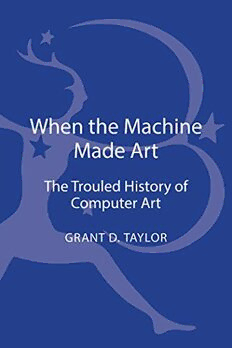Table Of ContentWhen the
Machine Made
Art
INTERNATIONAL TEXTS IN CRITICAL
MEDIA AESTHETICS
VOLUME 7
Founding Editor
Francisco J. Ricardo
Series Editor
Jörgen Schäfer
Editorial Board
Rita Raley
John Cayley
George Fifield
Tony Richards
Teri Rueb
When the
Machine Made
Art
The Troubled History of
Computer Art
GRANT D. TAYLOR
International Texts in Critical Media Aesthetics
NEW YORK • LONDON • NEW DELHI • SYDNEY
Bloomsbury Academic
An imprint of Bloomsbury Publishing Inc
1385 Broadway 50 Bedford Square
New York London
NY 10018 WC1B 3DP
USA UK
www.bloomsbury.com
Bloomsbury is a registered trade mark of Bloomsbury Publishing Plc
First published 2014
© Grant D. Taylor 2014
All rights reserved. No part of this publication may be reproduced or
transmitted in any form or by any means, electronic or mechanical,
including photocopying, recording, or any information storage or retrieval
system, without prior permission in writing from the publishers.
No responsibility for loss caused to any individual or organization acting on or
refraining from action as a result of the material in this publication can be
accepted by Bloomsbury or the author.
Library of Congress Cataloging-in-Publication Data
Taylor, Grant D.
When the machine made art : the troubled history of computer art / Grant D. Taylor.
pages cm – (International texts in critical media aesthetics)
Summary: “Examines the cultural and critical response to computer art,
by identifying the destabilizing forces that affect, shape, and eventually
fragment the computer art movement”– Provided by publisher.
ISBN 978-1-62356-795-8 (hardback) – ISBN 978-1-62356-884-9 (paperback)
1. Computer art. I. Title.
N7433.8.T39 2014
776 – dc23
2013046891
ISBN: HB: 978-1-6235-6795-8
PB: 978-1-6235-6884-9
ePub: 978-1-6235-6272-4
ePDF: 978-1-6235-6561-9
Typeset by Integra Software Services Pvt. Ltd.
To Victoria and Vivienne
CONTENTS
Acknowledgments viii
Introduction: Unorthodox 1
1 Future crashes 25
2 Coded aesthetics 65
3 Virtual renaissance 103
4 Frontier exploration 157
5 Critical impact 201
Epilogue: Aftermath 249
Notes 268
Bibliography 305
Index 321
ACKNOWLEDGMENTS
The research that provided the backbone to this book was
conducted at two institutions on two continents. While pursuing
scholarship in Australia and doing the same in the United States
often differed in significant ways, the generous support of my
colleagues remained the same. At the University of Western Australia
in Perth, scholars such as Clarissa Ball, Patrick Beale, Richard
Read, Nicole Sully, and Ian McLean provided helpful suggestions
and challenged my thinking at every moment. At Lebanon Valley
College in Annville, Pennsylvania, I received the same type of
assistance—individuals with a critical focus willing to assist a
colleague in completing a large research project. The members of
the art and art history department—Karen Beall, Barbara McNulty,
Dan Massad, and Michael Pittari—continually provided me with
positive reinforcement. To Jeff Robbins, I owe special thanks. An
ever-generous colleague, Jeff always gave sound professional and
publishing advice. Other peers, including Marc Harris, Rebecca
McCoy, Matthew Sayers, and Robert Valgenti, have provided
various forms of aid: from language translations to best practices.
Mike Green and the office of academic affairs also supported my
endeavors with multiple research and travel grants. Becky Fullmer’s
editorial work was instrumental in refining my manuscript. My LVC
student assistants Diana Jo Hoffman and Lindsay Snowden were
eager seekers of the most obscure and difficult reference materials. I
would like to say Diana’s service dog Emmy helped, but the truth is
she slept on my office floor while we toiled away. The librarian staff
at the Bishop Library also deserve recognition for their remarkable
attention to detail.
Within the global field of digital arts, I have numerous people to
thank. Many of these individuals I first met at the inaugural Media
Art Histories Conference in Banff, Canada, in 2005, and since
then they have provided me with much-needed guidance and vital
ACKNOWLEDGMENTS ix
research leads. These individuals include Darko Fritz, Charlie Gere,
Douglas Kahn, Frieder Nake, Margit Rosen, and Eddie Shanken.
Paul Brown, Hannah Higgins, and Nick Lambert have also
supported my research at salient moments. I thank Jörgen Schäfer,
along with the editorial board of the International Texts in Critical
Media Aesthetics series, for bringing my narrative to light. Without
the endorsement of Francisco Ricardo, founding editor of the series,
this publication would not have been possible. I am grateful to the
staff at Bloomsbury Publishing, especially my editors Katie Gallof
and Laura Murray. I would also like to thank the Regents of the
University of California and the University of California Press for
allowing me to publish portions of my 2012 essay, “The Soulless
Usurper: Reception and Criticism of Early Computer Art,” which
was published in Mainframe Experimentalism: Early Digital
Computing in the Experimental Arts (edited by Hannah Higgins
and Douglas Kahn).
I am particularly indebted to two individuals, Anne and Michael
Spalter, who have provided unwavering support since the first
moment I arrived in the United States. Anne has been an advocate of
my research as far back as graduate school, and Michael introduced
me to Hannah Higgins and Francisco Ricardo—individuals who
opened up new scholarship paths for me. My correspondence with
Laurens Schwartz became invaluable for both its counsel and its
sense of friendship. One could say we formed a bond through layers
of analogical expression. I am also appreciative of the countless
artists who have invited me into their studios and homes. Viewing
their artworks and searching their archives have provided continual
sustenance for my intellect and imagination. Finally, I would like
to thank my family in the United States and Australia, for without
their emotional support and devotion a project of this magnitude
would not have been possible.

